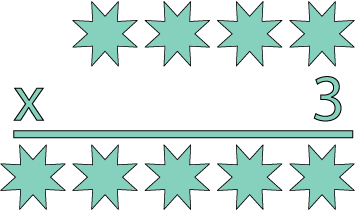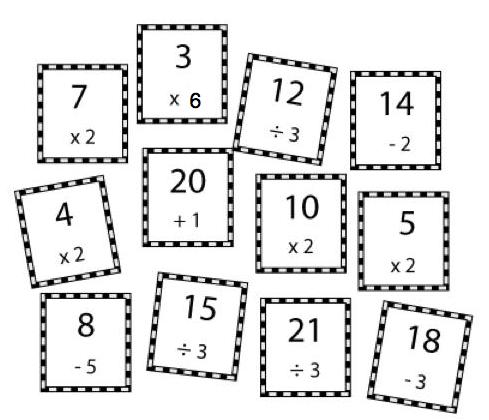This was a key session in the course and really the pinnacle of the programme. The idea of multiplication being a relationship between numbers is a difficult one to see and so not easy to explore.



 I wanted to make an activity that forced them to think in terms of multiplying numbers and that also might lead to the project idea of representing primes as parts and composite numbers as completed products.
I wanted to make an activity that forced them to think in terms of multiplying numbers and that also might lead to the project idea of representing primes as parts and composite numbers as completed products.
To encourage this idea, I tried a few things:
We looked at characteristics of different multiples and how tables of multiples are symmetrical. We looked at other tables that linked characteristics and asked about why the central diagonal didn't have symmetrical doubles.
We explored the patterns made by times tables in a 100 square.
I restricted the numbers to only the "friendly" primes. We explored the numbers created using 2, 3, 5, and 11 only. I called these the friendly primes because they have easily discoverable patterns in a 100 square.
I recommended the playing the app Alchemy that involves mixing base elements (Air, fire, water, earth) to make all kinds of compounds.
We started the session in Brixton using cards that had prime factors in the form of coloured dots on the back. I used this as a way to remind everyone about the colours introduced last week and to get questions and observations. The first two observations were about the card with 3 red dots (8 as it is 2x2x2) and three green dots (27 - 3x3x3) on first encounter, everyone assumed that they should be 6 and 9 respectively. I half explained half left them to figure it out. It would have been good to have some strategies for that. Even if I had just explained the homework rule that they can only use the numbers from the dots and the times button. That may have still caused them to think 2 x 3 instead of 2x2x2.
I don't think it was a big problem anyway. E and N went on to get the concept very well as did the rest of them I think. One or two didn't really get past the times tables on 100 square that we did last week but reinforcement of that is a good thing. I think the way C20 understood it afterwards was one of the best moments as he often does not get our activities or draw his focus away from whatever it was on but today he did a lot of the prime map and also asked questions about what he was doing and checked with me regularly.
 An activity that was very helpful for setting this one up was to create number system using the 100 square. We added blocks corresponding to the colours for that number. I started off with this one just letting them do what they wanted but had to work more strictly to get a good outcome. I took the board away and asked if they thought they could find some cards and then build a tower with the correct colours and number of blocks. They all got on well with that. transferring it to the paper copy was a little more difficult.
An activity that was very helpful for setting this one up was to create number system using the 100 square. We added blocks corresponding to the colours for that number. I started off with this one just letting them do what they wanted but had to work more strictly to get a good outcome. I took the board away and asked if they thought they could find some cards and then build a tower with the correct colours and number of blocks. They all got on well with that. transferring it to the paper copy was a little more difficult.
I tried a 2048 style game at the end but I haven't thought the rules through sufficiently yet so I'll try that another day. One thing is that I should leave out the miss a go part as too many goes were missed and that made the game too slow.
We started the session in Brixton using cards that had prime factors in the form of coloured dots on the back. I used this as a way to remind everyone about the colours introduced last week and to get questions and observations. The first two observations were about the card with 3 red dots (8 as it is 2x2x2) and three green dots (27 - 3x3x3) on first encounter, everyone assumed that they should be 6 and 9 respectively. I half explained half left them to figure it out. It would have been good to have some strategies for that. Even if I had just explained the homework rule that they can only use the numbers from the dots and the times button. That may have still caused them to think 2 x 3 instead of 2x2x2.
I don't think it was a big problem anyway. E and N went on to get the concept very well as did the rest of them I think. One or two didn't really get past the times tables on 100 square that we did last week but reinforcement of that is a good thing. I think the way C20 understood it afterwards was one of the best moments as he often does not get our activities or draw his focus away from whatever it was on but today he did a lot of the prime map and also asked questions about what he was doing and checked with me regularly.
 An activity that was very helpful for setting this one up was to create number system using the 100 square. We added blocks corresponding to the colours for that number. I started off with this one just letting them do what they wanted but had to work more strictly to get a good outcome. I took the board away and asked if they thought they could find some cards and then build a tower with the correct colours and number of blocks. They all got on well with that. transferring it to the paper copy was a little more difficult.
An activity that was very helpful for setting this one up was to create number system using the 100 square. We added blocks corresponding to the colours for that number. I started off with this one just letting them do what they wanted but had to work more strictly to get a good outcome. I took the board away and asked if they thought they could find some cards and then build a tower with the correct colours and number of blocks. They all got on well with that. transferring it to the paper copy was a little more difficult.I tried a 2048 style game at the end but I haven't thought the rules through sufficiently yet so I'll try that another day. One thing is that I should leave out the miss a go part as too many goes were missed and that made the game too slow.


















